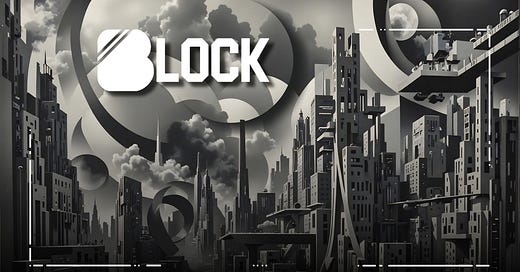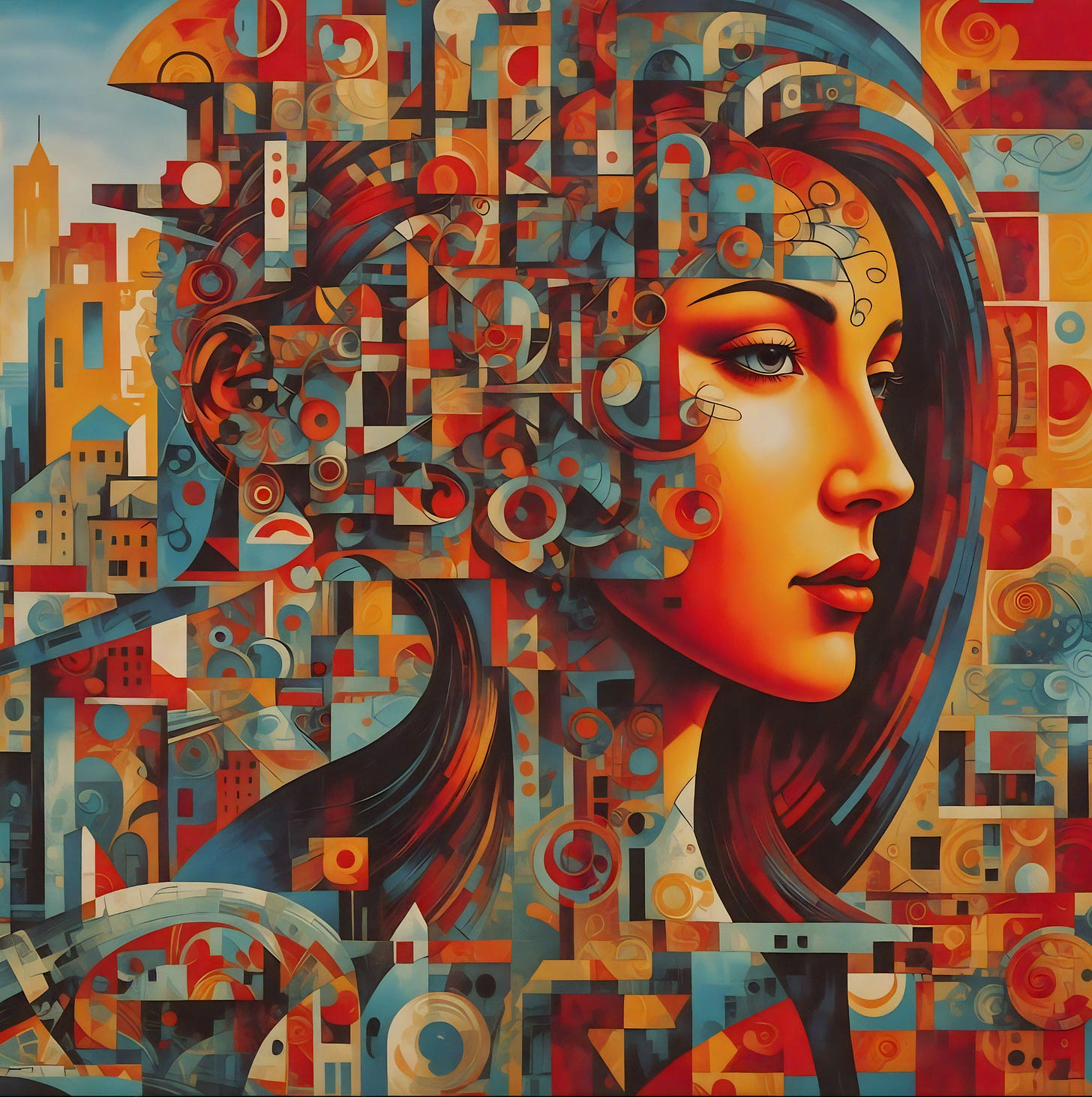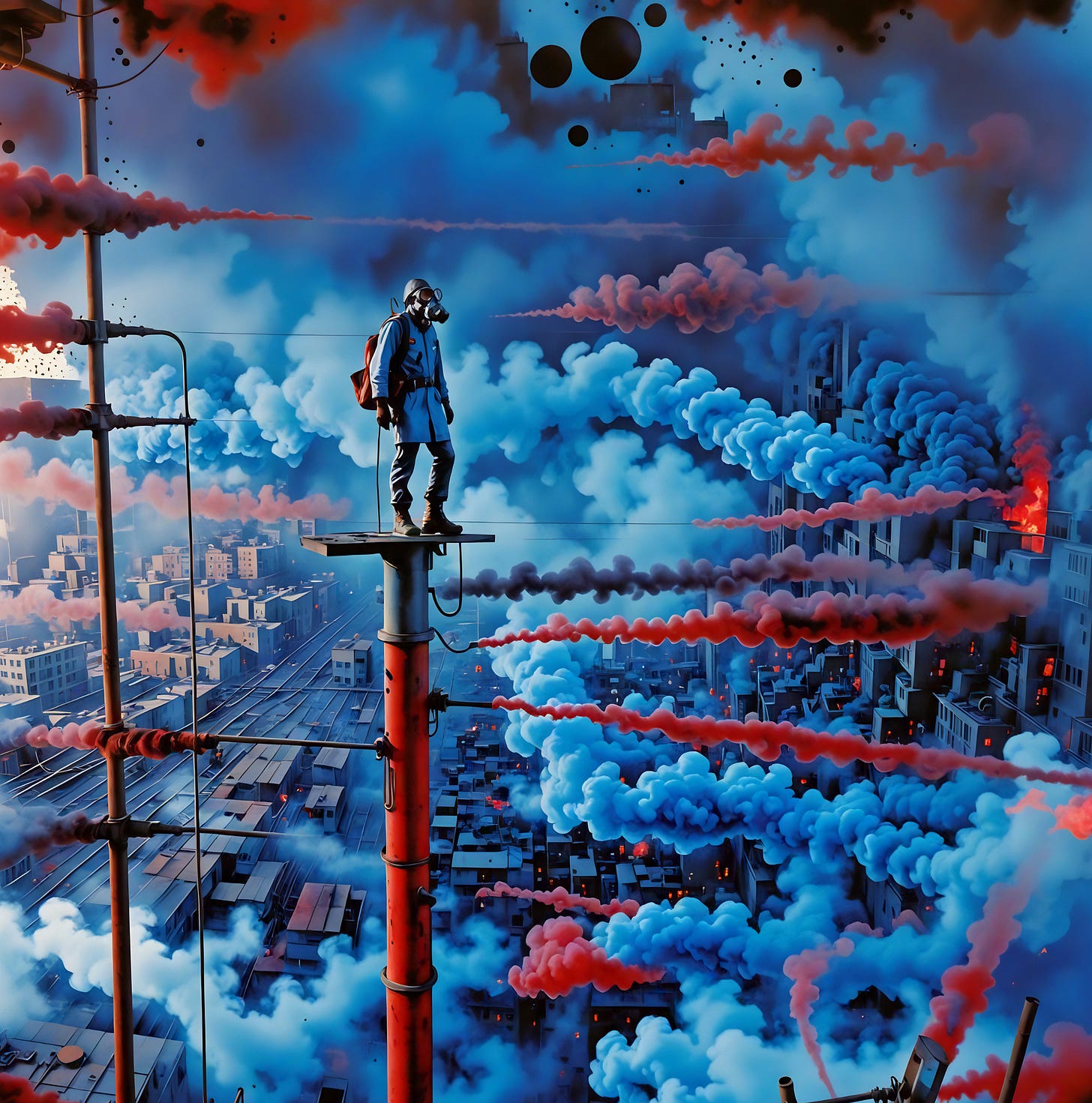NFT Edition: Le.sinthome–Psychology, Art, and Blockchain
How the unconscious merges with digital art.
It’s not every day that we come across an artist whose work captivates visually and delves deeply into the human psyche. Le.sinthome’s art stands at the crossroads of digital innovation and psychoanalytic exploration, a combination that feels both timely and timeless. Their ability to weave Lacanian concepts into digital art creates a profound dialogue between philosophy, the unconscious, and modern technology. And on this interview, we delve into the creative process and inspiration for their artwork.
The Artist’s Vision: Le.sinthome and Lacan
Interviewer: I want to start with something at the center of all, your name. Your pseudonym, ‘le.sinthome,’ references a concept from Lacanian psychoanalysis. Can you share what drew you to this idea and how it forms the foundation of your artistic practice?
Le.sinthome: The sinthome is a concept introduced by Jacques Lacan that revolves around three interwoven orders: the Real, the Imaginary, and the Symbolic. The Real is the ungraspable, the realm of pure existence that language can never fully capture. The Imaginary relates to images, illusions, and how we see ourselves and others. The Symbolic is the order of language, law, and social structures—the framework that gives meaning to our world.
Lacan envisioned these three orders as a Borromean knot, a structure in which all three rings are interdependent. If one is cut, the whole knot falls apart. The sinthome—an archaic spelling of the word "symptom"—acts as a fourth ring in this knot, providing stabilization. But unlike a symptom, which signals a problem to be solved, the sinthome is unique to each individual. It is an anchor, a unique thread that holds together the contradictions of one’s psyche.
Take James Joyce, for instance. Lacan famously analyzed Joyce’s writing style and concluded that his art functioned as his sinthome. Joyce’s experimental use of language—his Finnegans Wake in particular—acted as a stabilizing force, substituting for the paternal function (which Lacan associates with the Symbolic). His writing wasn’t just a creative act; it was the very thing that allowed him to maintain psychic equilibrium.
In my practice, the sinthome represents that unique knot of contradictions and singularities that makes each of us who we are. It’s something you embrace as a part of your being. My art explores this by creating visual forms that resist clear interpretation but resonate on a deeper, more personal level. I want viewers to engage with the contradictions and tensions within themselves, to confront their own sinthome through the work.
I: Do you see the ‘sinthome’ as a metaphor for your personal journey as well?
LS: Absolutely. For me, the sinthome is not just a metaphor but a living structure. It reflects the way I navigate my own contradictions, weaving fragmented experiences into something coherent through the act of creation. My art is both the result of this process and a record of it—an ongoing negotiation of meaning where the act of creating stabilizes the chaos.
Every piece I create is an attempt to engage with my own knots. In a way, my art is both a reflection of that journey and the journey itself. It’s a process of continual negotiation, where the act of creating becomes a way to hold the threads together, even when they seem like they might unravel.
I: Your art has been described as ‘madness aversion.’ Could you explain how this concept plays out in your creations, and why it feels particularly urgent in today’s fragmented world?
LS: Madness, in Lacanian terms, isn’t about being “crazy” in a colloquial sense; it’s what happens when the Symbolic order—the framework of meaning that holds our world together—collapses. Without this structure, we lose the ability to navigate reality, and chaos takes over.
“Madness aversion” is about confronting the disorientation of modern life without being consumed by it. In my work, abstraction becomes a tool for this confrontation. Abstract forms and layered imagery mirror the fragmentation of our world, but they do so in a way that invites engagement rather than avoidance. They challenge viewers to linger in ambiguity, offering not answers but a symbolic framework to stabilize their own disorientation. This is particularly urgent today, as our shared structures of meaning become increasingly fragmented.
Artistic Process and Inspirations
I: Your work invites viewers into a dialogue with the unconscious. How do you approach the process of creating art that engages so deeply with these psychological themes?
LS: The unconscious, as Lacan famously said, is structured like a language—but it’s not a language we can directly access. It speaks in slips, symbols, and fragments. My process mirrors this structure. I don’t approach my work with a fixed message or narrative in mind. Instead, I let the forms, textures, and colors emerge organically, like free association on a visual plane.
This approach is less about “expressing” the unconscious and more about creating a space where it can reveal itself. The ambiguity in my work—the tension between form and formlessness, meaning and opacity—is intentional.
I: Are there specific emotions or mental states you aim to evoke in your audience?
LS: Ambivalence and unease are central to my work, but they are not simply negative emotions. In Lacanian terms, unease is akin to anxiety—a growing tension that builds as one approaches deeper truths. In psychoanalysis, this anxiety isn’t something to be avoided; it’s something that leads to transformation. My art mirrors this process. The unease it evokes is not an end but a beginning: an invitation to confront the contradictions and unresolved tensions within oneself. As this unease deepens, it transforms into curiosity and introspection, which allows the viewer to engage with the work in a more profound way.
I: In series like ‘Memories from Future Past,’ you explore themes of time and perception. How does this connect to your psychoanalytic inspirations?
LS: Time, in psychoanalysis, is never linear. Our pasts are constantly rewritten by our present perceptions, and our futures are shaped by unconscious repetitions of what came before. “Memories from Future Past” plays with this elasticity of time. By juxtaposing elements that feel both ancient and futuristic, I aim to collapse temporal boundaries, creating a sense of timelessness—or time out of joint.
The unconscious constantly rewrites the past based on present desires, and unresolved repetitions from the past shape the trajectory of our future. Memories are not static snapshots—they are dynamic, reframed by the emotional and symbolic significance we assign to them in the present. Similarly, the future is haunted by what remains unresolved in our history. In this sense, the human experience of time is inherently “out of joint.”
My work reflects this tension. It doesn’t attempt to restore order to time but instead invites viewers to sit with the dislocation, to see the beauty and meaning that emerge from a world where time refuses to behave. By confronting these ruptures, we can uncover deeper truths about ourselves and the ways we construct meaning across the temporal layers of our lives.
The Medium as a Message
I: You’ve spoken about reshaping digital media into a vessel for symbolic resilience. What challenges have you faced in using NFTs and digital art to convey such profound ideas?
LS: I don’t approach my work with the intent of communicating concepts. Instead, I work within the Lacanian framework, allowing the art to emerge as a process of its own, detached from the need to explain or teach.
The challenge lies more in resisting the pull of the NFT space’s focus on immediacy and spectacle. Digital platforms thrive on surface-level appeal, but my process embraces the gaps, the ruptures, and the ambiguity that resist instant consumption. I trust the work to take care of itself, and to resonate with those willing to engage with it on its own terms.
This approach means relinquishing control over how the work is interpreted, aligning with Lacan’s idea that meaning always exceeds intention. The art isn’t about delivering a message; it’s about opening a space where symbolic resilience can emerge. The blockchain, with its permanence, becomes the perfect site for this interplay.
I: Your work carries a rich philosophical depth while remaining visually striking. How do you balance the intellectual rigor of psychoanalysis with the demands of digital aesthetics?
Aesthetics are the gateway; philosophy is the foundation. I don’t see them as competing forces but as complementary ones. The visual allure draws viewers in, but the conceptual depth keeps them engaged.
Audience and Marketplace
I: Your art seems to encourage introspection and confrontation with the unconscious. What role do you hope it plays in the lives of those who collect or view it?
LS: I hope my art serves as a mirror—not one that simply reflects, but one that refracts, distorts, and reveals layers of the viewer they may not have recognized. It’s about creating a space where introspection becomes inevitable.
The unconscious, after all, isn’t something external to us; it’s always present, shaping how we navigate the world. My art aims to create moments of pause, where people can step outside the rush of everyday life and encounter something raw, unresolved, and deeply personal. The goal is not catharsis but awareness—a confrontation with the hidden threads that run through their experiences and identities.
For those who collect or engage deeply with my work, I hope it becomes more than just an object or image. I want it to be a catalyst—a piece they return to, finding something new each time, as if the work evolves alongside them. In a world that often encourages superficial engagement, my art seeks to foster a deeper, more lasting relationship with the self.
I: Have you been surprised by how audiences interpret your work?
LS: Surprise is inevitable—and fascinating—because once a piece leaves my hands, it’s no longer just mine. Lacan’s notion that meaning always exceeds intention rings true here. Audiences often bring interpretations that are wildly different from what I envisioned, but this doesn’t frustrate me; it excites me. It proves that the work is alive, functioning as a symbolic space where viewers can confront their own unconscious.
What’s particularly surprising is how often people reveal aspects of the work I hadn’t consciously considered, as if they’re excavating layers I didn’t even realize were there. In some ways, they become co-creators, shaping the piece through their engagement. This underscores one of the principles I value most: that art doesn’t dictate meaning—it generates it through interaction.
I: In a marketplace often focused on visual appeal, your work stands out for its intellectual and philosophical layers. How do you navigate the commercial aspects of NFTs while staying true to your artistic philosophy?
LS: I don’t shape my work to fit commercial trends or expectations. My focus is on the process and the art itself, trusting it to resonate with those who are drawn to its openness and complexity. NFTs, with their permanence and accessibility, offer a unique opportunity for the art to live in a decentralized space, untethered from traditional gatekeeping or the need for direct explanation. This aligns perfectly with my approach, as the work remains autonomous, letting viewers bring their own interpretations and responses to it.
My philosophy remains intact because it doesn’t seek to control or cater but to create and allow space for others to encounter the work on their own terms.
Future Exploration
I: As digital art and psychoanalysis evolve, how do you envision your creative universe expanding? Are there particular technologies or theories you’re excited to explore?
LS: My artistic background comes from film and literature and has always rooted my work in a fascination with narrative, but not the kind of narrative we often see today. Modern storytelling, heavily influenced by scientific materialism, tends to follow a rigid logic of linearity—biographies, documentaries, and other narrative forms built around a chronological progression, where events unfold according to predictable cause-and-effect sequences. This approach reflects a worldview shaped by the mechanistic assumptions of modern science: that the world operates as a system of measurable, sequential interactions. While effective in charting the material world, it often flattens the complexities of inner life, ignoring the ruptures, contradictions, and leaps that define the subjective experience.
In contrast, my interest lies in narratives that resist this deterministic framework. Drawing inspiration from psychoanalysis and Hegelian dialectics, I see storytelling as something far more layered and dynamic. Hegel’s philosophy reminds us that progress and meaning emerge not through smooth continuity but through contradiction and negation—through tensions that collide and resolve in unexpected ways. The subjective world reflects this: memory, desire, and identity don’t unfold neatly but exist as fractured, overlapping processes.
As digital art continues to evolve, it offers tools uniquely suited to exploring these kinds of narratives. Technologies like AI, generative systems, and virtual reality aren’t just about creating; they open new modes of storytelling. AI, for example, can introduce unexpected patterns or disruptions, provoking us to rethink traditional structures. Virtual reality, on the other hand, allows for immersive narratives where the viewer isn’t just a passive observer but an active participant, engaging with a story that unfolds in multiple dimensions simultaneously—more like memory or dream than linear exposition.
What excites me most is the potential to create narratives that reflect the true complexity of human experience—stories that don’t proceed step by step but emerge through collisions, tensions, and transformations. These are narratives that embrace the disjointed, nonlinear nature of our lives, showing that meaning isn’t something preordained but something forged in the interplay of contradictions. This, to me, is the real potential of digital art: not to replicate what has been done before, but to offer something new, a narrative form that mirrors the richness of what it means to be human.
I: If there’s one message or experience you want people to take away from your art, what would it be?
LS: The questions matter more than the answers. My work is an invitation to embrace ambiguity, to confront the parts of yourself that resist clarity. Meaning isn’t something static or given—it’s something we actively create, especially in a world where traditional sources of meaning have eroded. We’re living in a time when shared narratives, communal bonds, and even a sense of personal purpose feel increasingly fragmented. This loss of meaning isn’t just about individual disorientation; it’s a collective challenge, reflected in the anxiety, polarization, and uncertainty that define so much of contemporary life.
My art is not about providing solutions or imposing a singular interpretation. Instead, it offers a framework for engaging with life’s inherent ambiguity. Life is messy and contradictory, and that’s precisely where its richness lies. Through my work, I hope to encourage people to confront this chaos and rediscover the agency to shape meaning in their own lives.
The loss of meaning, paradoxically, creates a fertile ground for reimagining. If my art can help someone see ambiguity not as a void but as a source of potential, then it’s done its job.
I: Thank you so much for sharing your insights and reflections with us today. This conversation has been an incredible journey into your artistic universe. Before we wrap up, we’d love to give you the floor. Is there any project you would like to share?
LS: Thank you! You can check my art here:











impressive ❤️